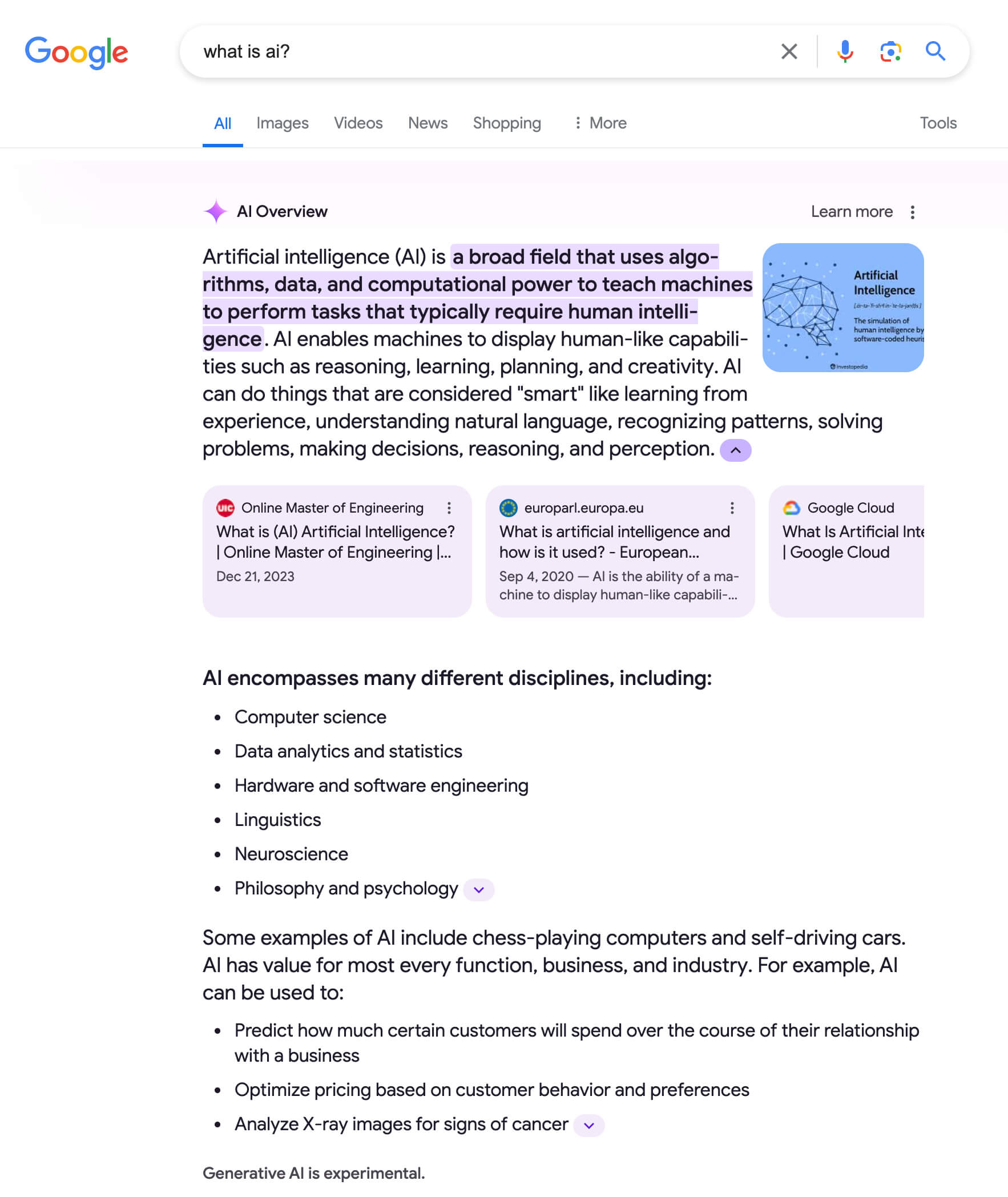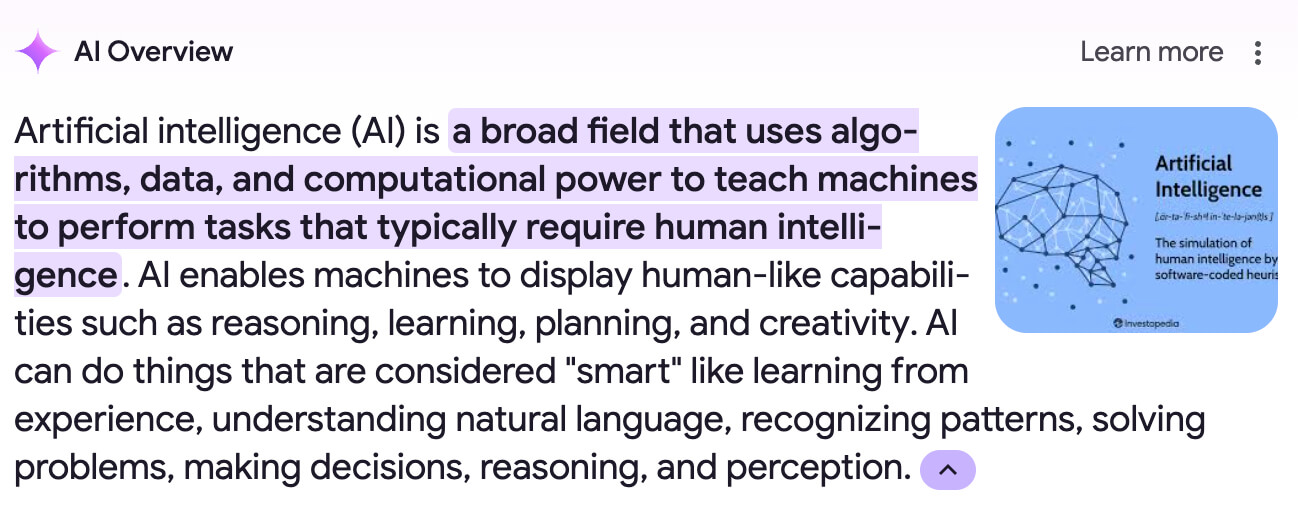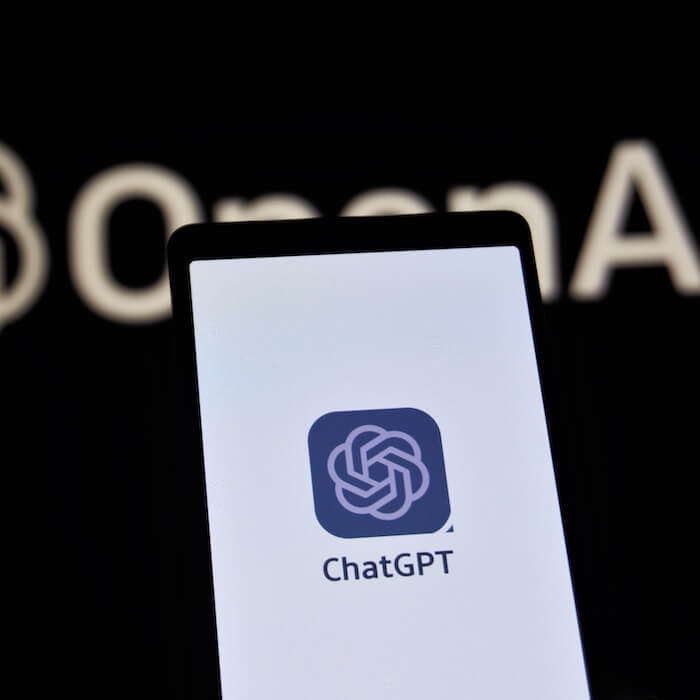
AI Overviews: Influencing Google AI Search
May 17, 2024|Read time: 7 min.
Key Points
- Google’s AI Overviews (formerly SGE) is a powerful example of an AI search engine and reveals where brand marketers need to go in order to keep up.
- AI Overviews uses thousands of data points, pulled from live web pages, to create its sophisticated and valuable answers. Fortunately, brands can be part of the storytelling.
- Brands that build networks of owned assets through OAO provide AI Overviews and future AI search engines with the content they need to tell their stories in brand-friendly ways.
Artificial intelligence-powered search engines have arrived, and it’s surprising just how intuitive and useful they are. AI Overviews, formerly Google Search Generative Experience (SGE), builds upon the search engine’s rich user experience, adding a generative search result stack to the SERPs.
Google SGE was an experimental feature and it has since moved into public release as AI Overviews in May 2024. It’s now activated by default in Google Search. Brands must execute strategies to influence what AI Overviews will say about them.
Here, we share how AI Overviews works, the risks, and how the holistic owned asset optimization process provides added brand control in a sustainable, and ethical manner.
What is Google’s AI Overviews?
AI Overviews is Google’s revolutionary AI search offering. It creates AI-generated answers to Google searches using publicly available, crawled web page content.
This search feature doesn’t always appear for all queries and more testing and time is necessary to see exactly how it will perform.
Why AI Overviews and AI search matters
Each AI innovation promises to change the marketing landscape, but AI search is perhaps the most volatile area where tectonic shifts may occur. And, with Google controlling nearly all of the search market share, AI Overviews is the one to watch.
AI Overviews should be a top priority for brand marketers as it poses risks and creates opportunities, much like OpenAI’s ChatGPT and similar AI offerings.
Generative search has implications for reputational defense and management, and adds even more to think about within the overall AI marketing space.
AI Overviews brand risks:
- AI Overviews is a new and prominent voice that can challenge brand narratives.
- It is not controlled, or controllable, in traditional ways.
- Like other AI tools, AI Overviews can make mistakes.
- It may return unflattering results.
- It will reach billions of eyes.
- Results can reflect negative news cycles.
- Results rely on live web content.
AI Overviews brand opportunities:
- AI Overviews can become a strong brand narrative supporter.
- What AI Overviews generates is authoritative for Google users.
- It allows brand-owned and brand-friendly content as sources.
- It can become an important asset in a brand’s OAO arsenal.
- It takes up major real estate on the search results page.
The AI Playbook for Marketing Execs
Packed with insights on influencing AI search, AI governance, and how to use AI with maximum impact and less risk.
AI Overviews in action
AI Overviews’ user flow is minimal and intuitive, and we expect even more features in the future.
As of now, AI Overviews shares the search box with standard Google search. A user performs a search and gets the standard results. AI Overviews then generates a response to that search on top of the SERPs or sometimes blended in lower on the page.
AI Overviews creates a multi-paragraph answer when it has enough data. It also provides a carousel of various sources (live, crawled web pages and more) that were used to generate the answer. Users can visit these sources to see the specific content AI Overviews relied on to create that answer.
Breakdown of AI Overviews
As mentioned above, AI Overviews has a number of components, and it’s worth examining each. Below we break down AI Overviews with screenshots of a recent search.
For the sake of staying in the newsworthy AI space, we searched ‘what is AI?’ in this example.
Here’s a look at the overall results:

Answer to the query
AI Overviews’ answer section provides fully AI-generated content and responds to any query, supplementing the SERPs with substantial written material. With many AI Overviews searches, Google users may not need to even leave Google to get the answer they’re seeking. In this way, AI Overviews produces remarkable value for its users and brands can add to that value.

AI Overviews can produce content around brands and related searches. These answers reflect facts about brands but also change depending on factors such as negative news cycles, controversy, and reputation-damaging events.
Brands need their own content to mitigate the risk that AI Overviews generates unflattering, inaccurate, or harmful content. But it’s not about obscuring the truth, it’s about brands offering their narrative, across their assets, to better inform AI tools.
Sources

AI Overviews does us the favor of showing exactly what it used to generate answers, unlike many other tools. With each answer, we get a convenient carousel and each tile represents a piece of the puzzle AI Overviews uses to assemble the whole.
Our search used several sources but each time you generate an answer. AI Overviews uses a mixture of sources like Wikipedia, Google’s knowledge graph, news and media sites, social media, forums, and even brand-owned sources.
Also known as owned, managed, and leveraged assets, each source tells part of the story. As a networked whole, they become AI Overviews’ story about your brand. Brands that invest heavily in their owned assets almost automatically begin building control and start influencing AI search in a positive, more accurate direction.
Influencing AI Overviews results
Now let’s look at how your brand can defend against AI Overviews’ risks, and turn its opportunities into wins.
It is worth noting that when we talk about influencing AI Overviews, we’re actually talking about providing the human audience with as much value-rich content as possible aimed at solving their problems.
When you build exceptional content experiences for humans searching on Google, you’re automatically giving AI Overviews what it wants so that it can better understand your brand. When AI Overviews understands your brand it produces answers your audience can readily connect with.
Here’s what we recommend to get started:
1. Know where you stand
Ask AI Overviews
The first thing is to get an idea of where you stand from AI Overviews’ perspective. It’s as simple as performing some queries consumers might ask or search about your brand.
A few ideas to ask AI Overviews to generate (note that the tool doesn’t always produce an answer so you should experiment):
- Search something like “Is [brand] legit?”
- Search around the specific industry: “What are the best [your industry] brands?”
- Search for other brand-related topics like news or controversy.
Each time you ask a given question, you’ll get a new answer and each generation will rely on a collection of sources, often with overlap.
Assess
Review what AI Overviews creates and you can develop an overall feel for where you stand. Additionally, you can figure out what kind of sources AI Overviews is using.
Controlled-to-uncontrolled ratio
The most important thing at this stage is the controlled-to-uncontrolled ratio.
Look at the sources. How many are fully brand-controlled (corporate site, blog, etc.) versus completely uncontrolled (media, reviews, etc.)?
You want a mix that leans strongly towards brand-owned sources, or as much as possible. This provides more influence over AI Overviews’ results. A mix that leans too much towards non-owned sources diminishes narrative control and cedes the story you want to tell.
2. Uncover opportunities
Ultimately, this process reveals your vulnerabilities and gaps — those online spaces you’re leaving on the table — and helps set a course toward repair. When you know where you stand, the opportunities for influence come into focus.
Determine where you’re missing the mark, where your content is stale or out of date, and where you’re completely absent. Based on this assessment you can build out a strategy, including what content to create, social profiles to establish, and even bigger ideas like creating content hubs, and then execute on it.
This picture will look totally different across brands and industries. But from experience, we typically see a few key problems: unoptimized brand properties, old content, or no content at all.
This is a problem when it comes to connecting authentically with consumers, so it’s also a problem in the AI search context.
3. Build out your assets
Next, start creating the content and assets you need to connect with consumers and provide AI Overviews with the context and truth of your brand’s narrative. This is usually a long-term project. Depending on your industry or brand size, it potentially entails hundreds of assets and a deluge of content to support them.
Again, it’s important to understand that any work done to help AI search engines understand your brand also builds a stronger buyer’s journey and encourages authentic consumer connection.
This truth holds both ways and shows why OAO is so important in the AI search era.
4. Measure, iterate, repeat
Working to influence AI search tools is a process marked by constant evolution, much like the AI tools themselves. Brands must continually develop content and assets, assess performance, improve and evolve, and then repeat.
AI search tools, like consumer needs, evolve and change, as do entire industries. The most adaptable, agile, and iterative brands become the leaders as a result. Plan to evolve and deliver diverse value to your audience, AI and human alike.
The future of AI search
AI Overviews, as of May 2024, is very new and will improve based on user feedback and data collected by Google. Its algorithms will evolve, allowing for more sophisticated content. If your brand hasn’t been preparing for AI search, it’s not too late.
Start building an owned asset strategy, and you’ll achieve deeper audience connections and influence the AI tools that consumers are increasingly relying on.
Begin here:


Learn how consumer insights can drive consumer connection
What We DoUnlock instant access to 25+ digital marketing resources and the OAO 101 introductory email course to kick start your strategy.



